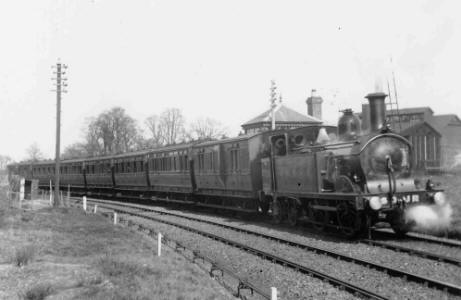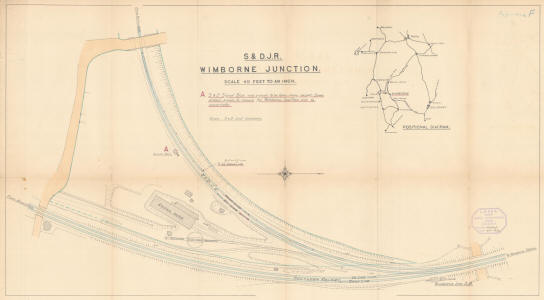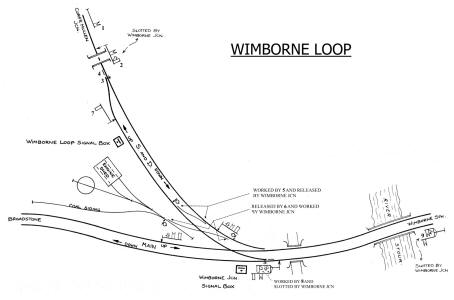 |
Somerset &
Dorset Joint Railway Wimborne Junction |
 |
||||
|
||||||
|
||||||
Wimborne Junction was situated in the county of Dorset at the southern end of the original 'main line' of the Somerset & Dorset Joint Railway (S&DJR). This part of the S&DJR had been constructed originally by the Dorset Central Railway (DCR), which diverged at Wimborne Junction from the line of the Southampton and Dorchester Railway via Ringwood. The junction was a short distance to the south of the actual Wimborne station, which was on the opposite side of the River Stour. The DCR line diverged away to the west at the junction and the S&DJR had a two-road engine shed in the 'V' of the junction.
 |
 | |
| Up train passing Wimborne Loop signal-box Click picture for larger image |
Plan of Wimborne Junction in 1925 Click drawing for larger image |
The first part of the DCR was opened in 1860 as a single-track line to Blandford, but later it was extended northwards to join with the Somerset Central Railway (SCR). In 1862 the DCR and SCR amalgamated to become the Somerset and Dorset Railway, which in turn became the S&DJR in 1875 when the line was leased jointly by the Midland Railway (MR) and London & South Western Railway (L&SWR). The L&SWR also acquired the Southampton & Dorchester Railway. After the Grouping of the railways of Great Britain in 1923 the S&DJR became a Joint line under the control of the London, Midland & Scottish Railway (LMS) and the Southern Railway (SR), who were the successors to the MR and L&SWR respectively. When the railways were nationalised in 1948 the Joint line came under the control of British Railways (Southern Region) (BR(SR)) and the southern end of the line remained in their control until the S&DJR closed on 6th March 1966.
When the first part of the DCR was opened in 1860 the Southampton and Dorchester Railway was still single-track and that line was not doubled west of Wimborne until 1863, although the viaduct across the River Stour had been constructed for double-track in 1847. It is believed that the DCR was constructed with a separate line (parallel to the existing line) across the viaduct from the station, probably without any connection between them where they diverged at the south end. However it is clear that a physical junction was provided eventually, as the Board of Trade (BoT) Inspection Report for the 1863 doubling mentions a 'signal box' at the 'junction'. Nothing more is known about that 'signal box', but it may have been little more than a small hut to provide shelter for the signalman, with a very primitive signalling infrastructure.
In 1872 the L&SWR opened a signal-box at Wimborne Junction, but few details are known about that box or its signalling installation. The actual junction was double-track, but the S&DJR line became single track after a short distance along the branch. However in 1878 the double-track on the branch was extended further from the junction and the S&DJR opened their own signal-box to control the point where that double-track became single-track. The new work was inspected for the BoT by Col Yolland and his Report is dated 18-April-1878 (The National Archives (TNA) file MT6/205/10). He stated that the new signal-box contained an interlocking frame with 9 levers, of which one was spare at that time, although associated plan evidence would suggest that the spare lever was brought into use almost immediately afterwards. There is only one known photograph of this signal-box, of which sadly only the roof and valancing are visible above a passing train, but it would appear to have been to the contemporary S&DJR Type 1 style.
[Note: one problem in discussing the S&DJR's signal-box at Wimborne Junction is to establish its 'correct' name! The L&SWR box was known as 'Wimborne Junction'. There are various references to the S&DJR box as 'Wimborne S&D Junction', 'Wimborne Loop' or 'Wimborne Single Line Junction' in different records. The term 'Wimborne Single Line Junction' appears to exist only in plans and documents of MR origin, reflecting the MR's usual terminology for such double-to-single locations. It appears to be the case that there are more references to 'Wimborne S&D Junction' than 'Wimborne Loop' and that the former are older than the latter. However the name Wimborne Loop has been adopted in RailWest for the S&DJR signal-box in order to avoid any possible confusion with the L&SWR Wimborne Junction box.]
About 1897 the L&SWR signal-box was replaced by a new signal-box located adjacent to it. This was an all-brick structure to the contemporary L&SWR Type 4 style and contained an interlocking-frame which is believed to have had 24 levers (20 working and 4 spare). Although the signalling on the L&SWR line may have been altered at that time (if not previously), it is believed that the change had little effect on the overall signalling arrangements for the S&DJR box. By 1915 the signalling at Wimborne Loop is believed have been as shown in the diagram below; any un-numbered signals and points were worked by Wimborne Junction signal-box, but for clarity some of its signals have been omitted.
 |
 | |
| Down train passing Wimborne Loop Down Home Click picture for larger image |
Wimborne Loop Signal Diagram circa-1915 Click drawing for larger image |
By the mid-1870s block working on the single-line sections of the S&DJR was by block telegraph without any train staff and Wimborne Loop would have worked by that method to Bailey Gate, which at that time was the next block-post up the line towards Blandford. However this system was replaced on 4-November-1886 by Electric Train Tablet (ETT) using Tyer's No 1 ETT instruments. After the opening of Corfe Mullen Junction on 16-April-1905 that signal-box became the next block post up the line from Wimborne Loop, but the method of block working remained unchanged. The original method of block working on the short section of double-track between Wimborne Loop and Wimborne Junction is unknown, but subsequently it was described in the 1905 S&DJR Working Timetable (WTT) Appendix as "ordinary L&SWR electric block signalling instruments". It is probable that those instruments were Preece 1-wire 2-position equipment, which was used on the L&SWR line through Wimborne at that time.
The signalman at Wimborne Loop was responsible for advising the crossing-keeper at Lake Crossing about the departure of trains entering the single-line section, and the following instructions were provided in the 1914 S&DJR WTT Appendix:-
|
INSTRUCTIONS to be OBSERVED as to the
USE of BELL SIGNALS BELL CODE
All Bell Signals are to be acknowledged by being repeated, and the "Call Attention" signal must in all cases be sent and acknowledged before the distinguishing Bell Signal is forwarded. The Signalman at S&D Wimborne Junction must send the Bell Signal to Lake Crossing for an Up Train on its passing his Post, and for a Down Train immediately Corfe Mullen Junction draws the Tablet. The instructions to Gate-keepers, Rules 116 to 124 inclusive, and all other Regulations in the Committee's Book of Rules and Regulations must be strictly attended to. |
Passenger traffic on the S&DJR line between Corfe Mullen Junction and Wimborne station ceased on 11-July-1920, although goods traffic continued until 1933. On 15-December-1927 (S&DJR Signal Instruction 285) the Down Distant (signal 1) was moved to a new location 354 yards further away from Wimborne Loop signal-box, where it was then 1,125 yards in rear of the Down Home (signal 2). At the same time the Distant signal was fitted with a yellow arm (in place of the old-style red arm) and a yellow glass (instead of red) for the 'on' aspect.
Wimborne Loop signal-box was closed on 1-April-1928 (S&DJR Signal Instruction 286) as an economy measure and its function was taken over by Wimborne Junction box. The ETT instrument for the section to Corfe Mullen Junction was transferred to Wimborne Junction box, but otherwise block working on the S&DJR single-line section remained unchanged. The following alterations took place to the former S&DJR signalling:-
All points and signals at the junction were now worked by Wimborne Junction box. There were other changes made at the same time, but these were not relevant to the S&DJR line and so further details have been omitted here.
On 18-June-1933 Wimborne Junction signal-box was closed, the actual junction was abolished and the S&DJR line to Corfe Mullen Junction was closed to all traffic, except for a small section retained at the Corfe Mullen end to provide access to a private siding (see the RailWest page on Corfe Mullen Junction for more details). Apart from the SR 'main line', all that remained in use thereafter at the site of Wimborne Junction was a short length of the former S&DJR line (now just a siding capable of holding 15 wagons) and the existing long siding (known as 'Canford Siding') nearest to the SR line. These two sidings were connected by a hand-point and then trailed into the SR Up line with a trap-point at their exit. This connection was worked by a new 2-lever Canford Siding ground-frame, which was released electrically from Broadstone signal-box. The details of these changes were contained in S&DJR Signal Instruction 338. The two sidings and Canford ground-frame were abolished on 13-September-1953 (Weekly Notice P/EW37).
© CJL Osment 2016-23
Acknowledgments to Colin Divall and Peter Russell for material from the Public Records
Office and other information.
Wimborne Loop 1915 diagram based on original by
the late George Pryer, courtesy of
Signalling Record
Society.
Photographs from the WCRA collection.
References